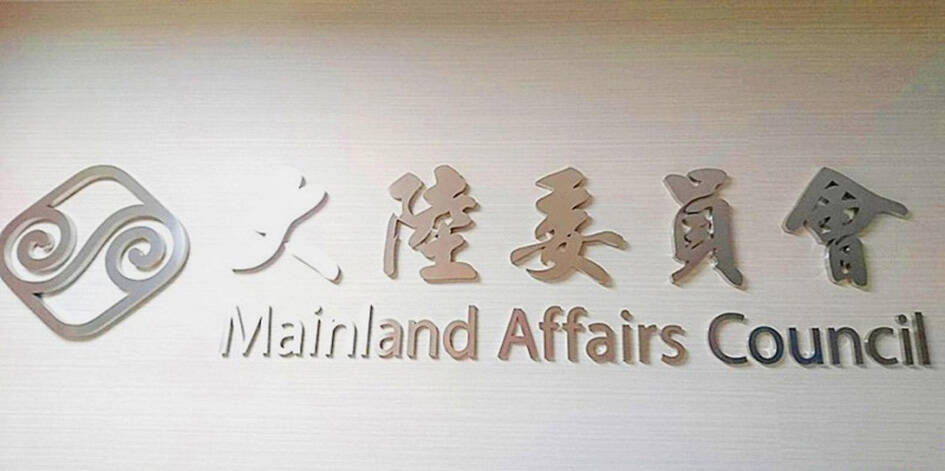China is likely to continue increasing its intimidation of Taiwan while expending “united front” efforts through cognitive warfare, a Mainland Affairs Council (MAC) report said yesterday.
The First-Quarter Report on the Situation in Mainland China cited Chinese Communist Party (CCP) No. 4 official Wang Huning (王滬寧) as saying at a meeting last week that China is to fully implement its “overall strategy” on Taiwan issues.
The strategy refers to what Chinese President Xi Jinping (習近平) said during the Chinese People’s Political Consultative Conference’s National Committee meeting and National People’s Congress in March that the CCP would firmly adhere to the “one China” principle and the so-called “1992 consensus,” resolutely opposing foreign interference and Taiwanese independence, the report said.

Photo: Chung Li-hua, Taipei Times
The report said that Chinese Minister of Foreign Affairs Qin Gang (秦剛) has said that Taiwanese independence forces are incompatible with peace and stability across the Taiwan Strait.
Chinese agencies including the Chinese Ministry of Foreign Affairs, the National People’s Congress’ Foreign Affairs Committee, the Taiwan Work Office of the CCP’s Central Committee and the Chinese Ministry of National Defense issued statements on April 6 criticizing President Tsai Ing-wen’s (蔡英文) April 5 meeting in the US with US House of Representatives Speaker Kevin McCarthy.
The Taiwan Work Office and the Taiwan Affairs Office (TAO) sanctioned Representative to the US Hsiao Bi-khim (蕭美琴), the Prospect Foundation and the Council of Asian Liberals and Democrats on April 7, the report added.
Beijing conducted three days of combat readiness patrols and “United Sword” operations around Taiwan from April 8, and the Chinese Ministry of Commerce launched an investigation into Taiwan’s trade restrictions on 2,455 Chinese products on April 12, it said.
China is intensifying its “united front” campaign, the report said, citing TAO Director Song Tao’s (宋濤) frequent meetings with Taiwanese to call for adherence to the “one China” principle and the “1992 consensus.”
The TAO lifted a ban on imports of fresh chilled beltfish and frozen Atlantic horse mackerel from Taiwan on March 15, and on April 1 removed requirements for a negative polymerase chain reaction test result within 48 hours before departure for cross-strait flight passengers, the report said.
China is also working to consolidate its “one China” framework internationally, it said.
Xi last month telling French President Emmanuel Macron and European Commission President Ursula von der Leyen that “expecting China to compromise on the Taiwan issue is wishful thinking” is an example of Beijing’s effort to strengthen its “one China” framework on the global stage, it said.
Chinese Central Foreign Affairs Commission Director Wang Yi (王毅) in February said that Taiwan has been part of China since ancient times and would never become a country, the report said.
The so-called “1992 consensus,” a term former MAC chairman Su Chi (蘇起) in 2006 admitted making up in 2000, refers to a tacit agreement between the Chinese Nationalist Party (KMT) and the CCP that there is “one China,” with each side having its own interpretation of what “China” means.
The Democratic Progressive Party has never acknowledged the existence of the “1992 consensus” or “one China” consensus.

SHIPS, TRAINS AND AUTOMOBILES: The ministry has announced changes to varied transportation industries taking effect soon, with a number of effects for passengers Beginning next month, the post office is canceling signature upon delivery and written inquiry services for international registered small packets in accordance with the new policy of the Universal Postal Union, the Ministry of Transportation and Communications said yesterday. The new policy does not apply to packets that are to be delivered to China, the ministry said. Senders of international registered small packets would receive a NT$10 rebate on postage if the packets are sent from Jan. 1 to March 31, it added. The ministry said that three other policies are also scheduled to take effect next month. International cruise ship operators

NUMBERS IMBALANCE: More than 4 million Taiwanese have visited China this year, while only about half a million Chinese have visited here Beijing has yet to respond to Taiwan’s requests for negotiation over matters related to the recovery of cross-strait tourism, the Tourism Administration said yesterday. Taiwan’s tourism authority issued the statement after Chinese-language daily the China Times reported yesterday that the government’s policy of banning group tours to China does not stop Taiwanese from visiting the country. As of October, more than 4.2 million had traveled to China this year, exceeding last year. Beijing estimated the number of Taiwanese tourists in China could reach 4.5 million this year. By contrast, only 500,000 Chinese tourists are expected in Taiwan, the report said. The report

The Forestry and Nature Conservation Agency yesterday launched a gift box to market honey “certified by a Formosan black bear” in appreciation of a beekeeper’s amicable interaction with a honey-thieving bear. Beekeeper Chih Ming-chen (池明鎮) in January inspected his bee farm in Hualien County’s Jhuosi Township (卓溪) and found that more than 20 beehives had been destroyed and many hives were eaten, with bear droppings and paw prints near the destroyed hives, the agency said. Chih returned to the farm to move the remaining beehives away that evening when he encountered a Formosan black bear only 20m away, the agency said. The bear

HORROR STORIES: One victim recounted not realizing they had been stabbed and seeing people bleeding, while another recalled breaking down in tears after fleeing A man on Friday died after he tried to fight the knife-wielding suspect who went on a stabbing spree near two of Taipei’s busiest metro stations, Taipei Mayor Chiang Wan-an (蔣萬安) said. The 57-year-old man, identified by his family name, Yu (余), encountered the suspect at Exit M7 of Taipei Main Station and immediately tried to stop him, but was fatally wounded and later died, Chiang said, calling the incident “heartbreaking.” Yu’s family would receive at least NT$5 million (US$158,584) in compensation through the Taipei Rapid Transit Corp’s (TRTC) insurance coverage, he said after convening an emergency security response meeting yesterday morning. National